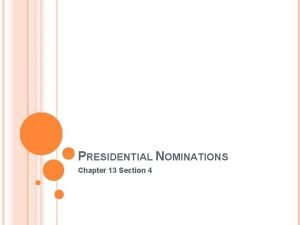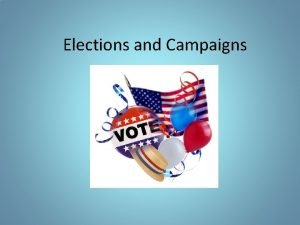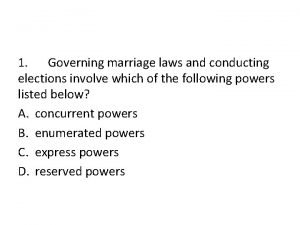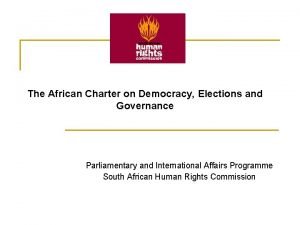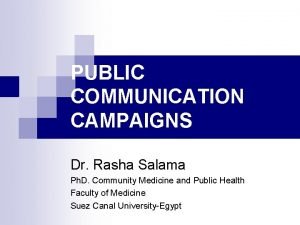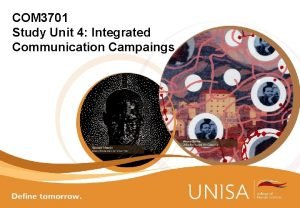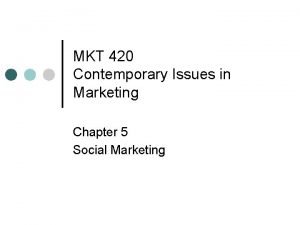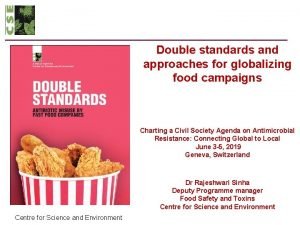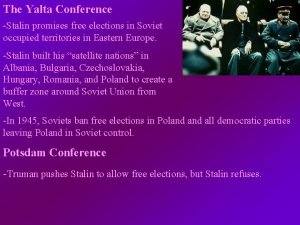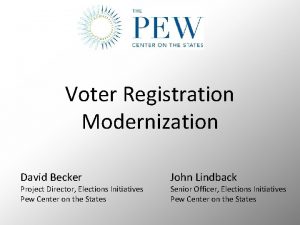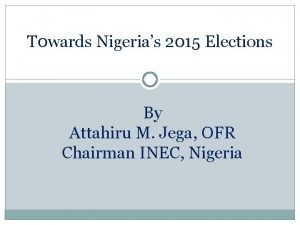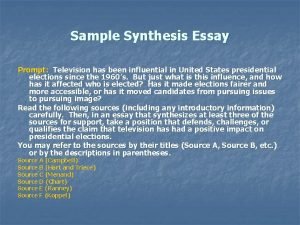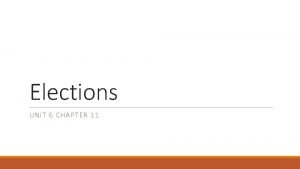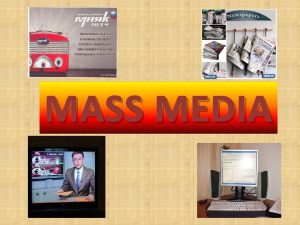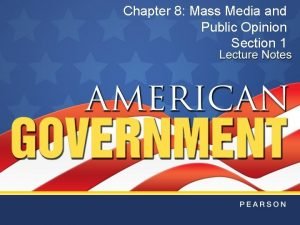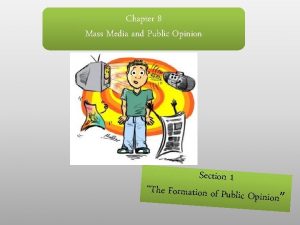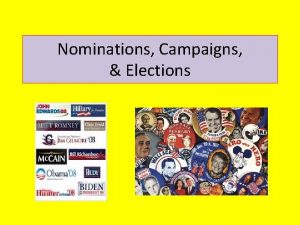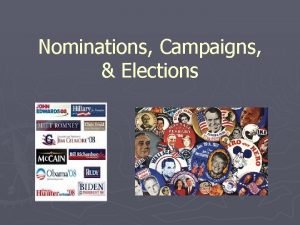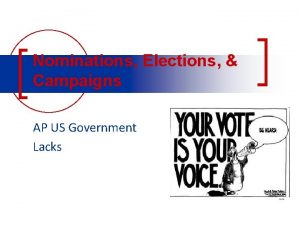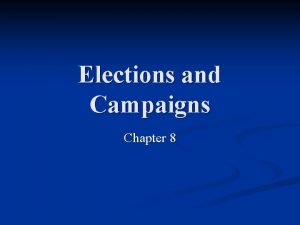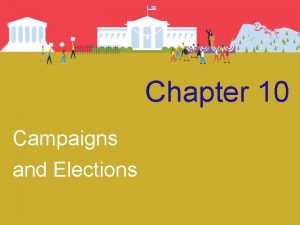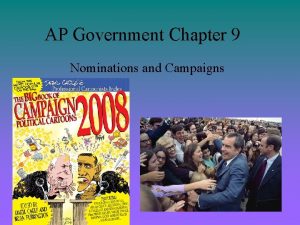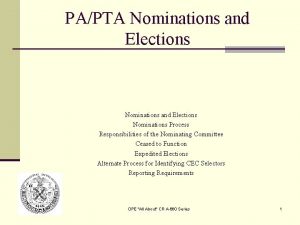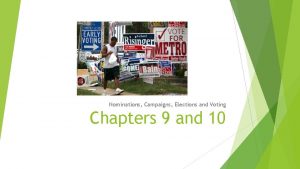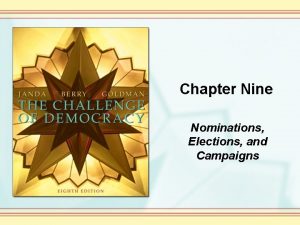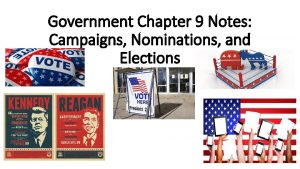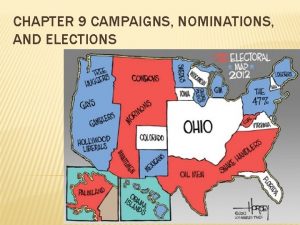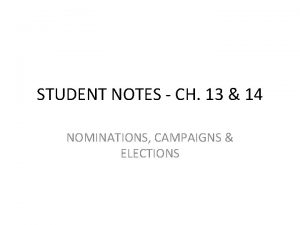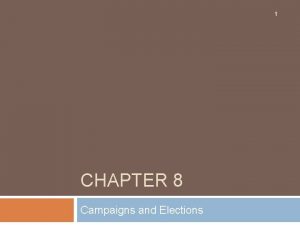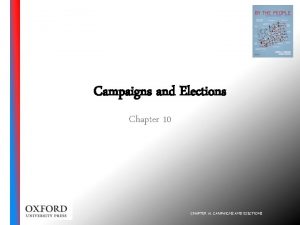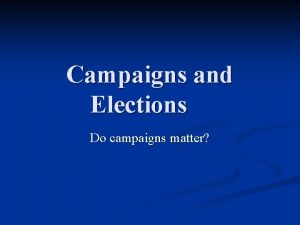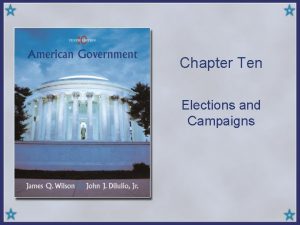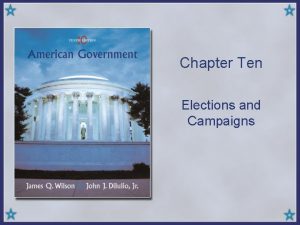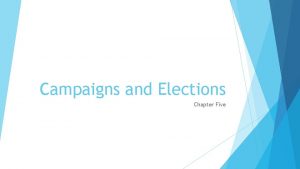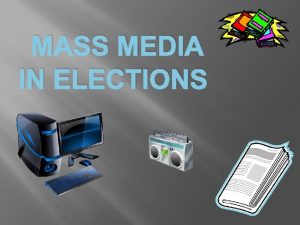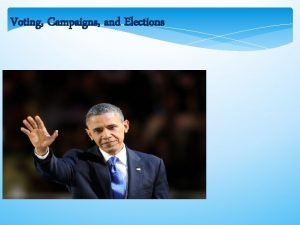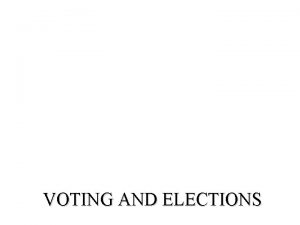Campaigns Elections and Mass Media Unit 4 Nominations




























- Slides: 28

Campaigns, Elections, and Mass Media Unit 4

Nominations Definition: the official endorsements of candidates for office by political parties l What is necessary for a candidate to win the nomination? – Momentum – Money – Media attention – Strategy l

Competing for Delegates Caucus l Primary l Frontloading l

Competing for Delegates l Evaluating the Primary/Caucus System – Disproportionate attention to early ones – Prominent politicians do not run. – Money plays too big a role. – Participation in primaries and caucuses is low and unrepresentative; 20 percent vote in primaries. – The system gives too much power to the media.

The Nomination Game

The Campaign Why did the primary/caucus system change the role of national conventions? l Why is the media a deciding factor in who gets elected? l Who is involved in a campaign “organization”? l

Money and Campaigning l The Maze of Campaign Finance Reforms – Federal Election Campaign Act (1974) l l Created the FEC and Presidential Election Campaign Fund Provided partial public financing for presidential primaries Provided full public financing for major party candidates in the general election Required full disclosure and limited contributions

Money and Campaigning l The Maze of Campaign Finance Reforms – What is “soft money”? – The Mc. Cain-Feingold Act (2002) banned soft money, increased amount of individual contributions, and limited “issue ads. ” – What are “ 527 s”?

Money and Campaigning The Proliferation of PACs – Political Action Committees (PACs): created by law in 1974 to allow corporations, labor unions and other interest groups to donate money to campaigns – PACs donate to candidates who support their issue. l What is the “doctrine of sufficiency”? l

The Impact of Campaigns have three effects on voters: – Reinforcement, Activation, Conversion l Why are campaigns sometimes ineffective at changing the outcome of elections? – Selective perception – Party identification – Incumbency advantage l

Understanding Nominations and Campaigns Does the nomination and campaign process promote democracy? l Do campaigns lead to an increased scope of government? l – Candidates make numerous promises, especially to state and local interests. – Hard for politicians to promise to cut size of government

How American Elections Work l Three types of elections: – Select party nominees (primary elections) – Select officeholders (general elections) – Select options on specific policies l Referendum l Initiative

Voter Apathy Downs voting theory l Political Efficacy l Civic Duty l Voter registration/Motor Voter Act l

Who Votes? l l l l Education – Most important factor Age Race Gender Marital Status Union Membership Cumulative effect

How Americans Vote l Mandate Theory of Elections l Party Identification l Candidate Image

How Americans Vote l Policy Voting – Basing your vote choice on issue preferences and where the candidates stand on policy issues – Unlikely to occur because: l l Candidates ambiguous “Horse race journalism” dominates – How does the primary system serve to increase policy voting?

How the Electoral College Works – # of votes based on congressional representation – Winner-take-all system dominant in states – Electors vote in December, reported in January – If no candidate gets a majority (270 votes), the House of Representatives votes for president (1 vote/state)

Small States Dominant?

Understanding Elections and Voting Behavior How do elections promote democracy? l How do elections impact the scope of government? l

Mass Media Politics How has technology changed politics? l Why has the process of image making become more important since the 1970 s? l

Print Media l Why is Print Media in decline? – Newspapers and magazines – Pecking order among newspapers l New York Times has largest impact

Broadcast Media l How did Broadcast Media change politics? – Brought government and politics into peoples’ homes – Politicians’ appearance and mannerisms more important

Broadcast Media The Federal Communications Commission (FCC) regulates the use of airwaves in three ways: l Prevent near monopoly control of market l Reviews performance of stations l Issues fair treatment rules for politicians l Narrowcasting: media programming on cable TV or Internet that is focused on one topic and aimed at a particular audience, e. g. , C-SPAN l Cable News Channels report on news as it happens and offer choices l

The Internet as News Source The Impact of the Internet – Internet is purposive—people choose what to learn about l Why is the purposive nature of Internet a concern for our democracy? l

Media Ownership How does private control of media outlets and the dependence on ad revenues endanger journalistic integrity? l Massive conglomerates account for over fourfifths of the nation’s daily newspaper circulation l Six companies own most of the broadcast media in this country l

Reporting the News Finding the News – Beats – Trial Balloons l Presenting the News – Sound Bites: short video clips – Less time devoted to covering political candidates – Interesting pictures, negative reporting l

The News and Public Opinion l How does television news shape public opinion? The policy agenda? l What is theory of political entrepreneurship?

Understanding the Mass Media How does media promote democracy? l How does media impact the scope of government? l How has media helped to increase the relative importance of the presidency? l
 Chapter 13 section 4 presidential nominations
Chapter 13 section 4 presidential nominations Salaam bombay! nominations
Salaam bombay! nominations Loser beck guitar
Loser beck guitar Presidential elections exploration and announcement
Presidential elections exploration and announcement Governing marriage laws and conducting elections involve
Governing marriage laws and conducting elections involve African charter on democracy, elections and governance
African charter on democracy, elections and governance Public communication definition
Public communication definition Interactive model of communication campaigns four phases
Interactive model of communication campaigns four phases International marketing campaigns
International marketing campaigns Informed delivery campaigns
Informed delivery campaigns Informed delivery campaign
Informed delivery campaign Strategic brand communication
Strategic brand communication Contemporary issues in marketing
Contemporary issues in marketing Fast food campaigns
Fast food campaigns Stalin promise free elections
Stalin promise free elections David becker elections
David becker elections Conclusion on elections
Conclusion on elections Ap lang synthesis essay television presidential elections
Ap lang synthesis essay television presidential elections “elections are key to democracy”
“elections are key to democracy” Relative atomic mass of beryllium
Relative atomic mass of beryllium Distinguish between mass number and atomic mass.
Distinguish between mass number and atomic mass. Atomic weight of oxygen
Atomic weight of oxygen Label the parts of atom
Label the parts of atom Unit 10, unit 10 review tests, unit 10 general test
Unit 10, unit 10 review tests, unit 10 general test Example of people in media
Example of people in media What is mass media answer
What is mass media answer Media and popular culture
Media and popular culture Chapter 8 mass media and public opinion worksheet answers
Chapter 8 mass media and public opinion worksheet answers Chapter 8 section 3 the mass media
Chapter 8 section 3 the mass media
